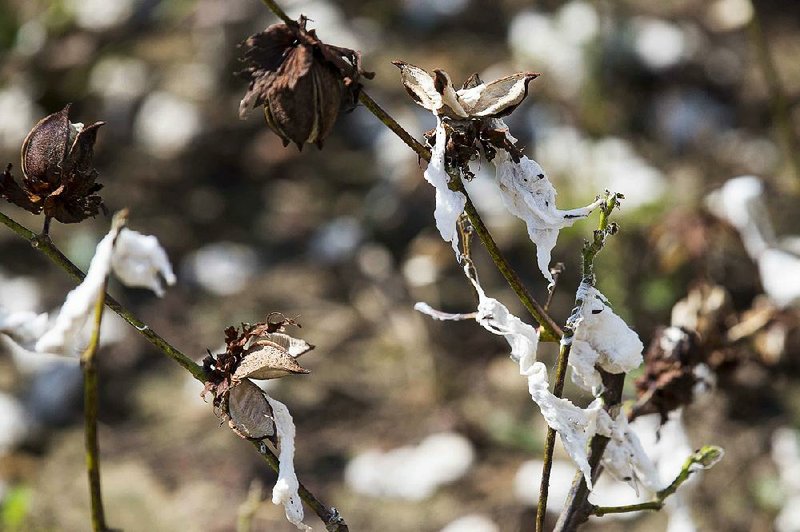ATLANTA -- Hurricane Michael left a snowy landscape of ruined white cotton on Georgia's red clay, destroying a crop and likely bringing hard times to the region's many small communities built on agriculture.
When the storm struck, most of the cotton was still in the fields, "wide open and susceptible to the wind," said farmer Ron Lee of McCleskey Cotton Co. in hard-hit southwest Georgia.
"Everything was just ready to harvest, so it couldn't have been a worse time," Lee said.
Georgia is the No. 2 cotton-producing state in the nation, trailing only Texas, U.S. Department of Agriculture statistics show.
Just 12 percent to 18 percent of Georgia's cotton crop had been harvested when Michael hit Georgia on Oct. 10, said Richey Seaton, executive director of the Georgia Cotton Commission. The powerful storm entered Georgia as a Category 3 hurricane and then tracked near the heart of the state's cotton country.
"Every row looked like snow on the ground," recalled Andy Lucas of the Georgia Farm Bureau, who went to south Georgia shortly after the storm to view the damage.
Before the storm struck, Lee was looking at the best cotton crop he'd seen in more than two decades, he said. He was still assessing the damage, but estimated a 50 percent to 70 percent loss. That could cost him $2.5 million to $3 million. But farmers to the south of him lost their entire crops, he said.
"These little towns like Dawson where I'm from, it's just a poor area of the state," he said. "Agriculture is the lifeblood of what's left."
Statewide, storm damage to Georgia's cotton crop amounted to $550 million to $600 million, University of Georgia agriculture officials estimated.
Overall, Michael's damage to Georgia agriculture amounted to nearly $3 billion, Georgia Agriculture Commissioner Gary Black said one week after the storm.
Michael wrecked many pecan trees, which take an entire decade to mature and begin producing nuts. Georgia's pecan crop sustained an estimated $560 million loss in the storm, Black said.
Vegetable crops, including sweet corn, cucumbers, squash, peppers and peas, took an estimated $480 million hit, the state Agriculture Department reported.
Many tall cornstalks were blown to the ground.
"It's just a green carpet," Lucas said.
Georgia's peanut harvest was somewhere around 45 percent to 50 percent complete, Lucas said. Officials were still assessing damage to buildings where peanuts are stored and dried, he said. Repair costs will be key in the final loss estimates for the peanut crop, the Agriculture Department reported. Early estimates of losses to the peanut crop range from $10 million to $20 million.
Georgia's poultry industry also sustained an estimated $25 million in losses, which includes the loss of 97 chicken houses and more than 2 million chickens, state agriculture officials said.
However, most of the state's poultry production is in north Georgia, which escaped the worst of the storm. The damage was in areas farther south, home to about 30 percent of the state's poultry industry, said Mike Giles, president of the Georgia Poultry Federation.
To the south, Hurricane Michael did substantial damage to Florida's cotton, peanut and fruit crops, nurseries and livestock.
The Florida Forest Service estimates the state lost almost $1.3 billion in timber that would have been harvested over several years.
Almost all of Florida's cotton crop was wiped out, with losses totaling about $51 million, the University of Florida Institute of Food and Agricultural Sciences reported in a recent study.
Florida's greenhouse, nursery and floriculture production suffered $39 million in losses and the state's peanut crop took a hit of $22 million. Damage to the area's livestock was around $23 million. Florida lost $9 million in vegetables and melons, $4 million in fruits and $3 million in tree nuts, including pecans.
Michael also caused more than $200 million in damage to Alabama agriculture, officials estimated. Alabama cotton farmers sustained the greatest losses, but other crops, livestock, poultry, and the timber industry were also damaged, according to Gary Lemme, director of the Alabama Cooperative Extension System.
Now, farmers and nearly everyone else across the region are bracing for the fallout.
Many of the small towns in Georgia's southwest corner were struggling already, and "all you got left are farming, chemical dealers, tractor salesmen, car and truck dealers," Lee said.
"They're going to feel the impact because you don't know what you have left, and you don't want to spend anything that you don't have," he said.
"It's going to be a long, long recovery," he added. "They'll feel it now, they'll feel it during holiday season and they'll feel it next year."
Information for this article was contributed by Gary Fineout and Mike Schneider of The Associated Press.
Business on 10/31/2018
